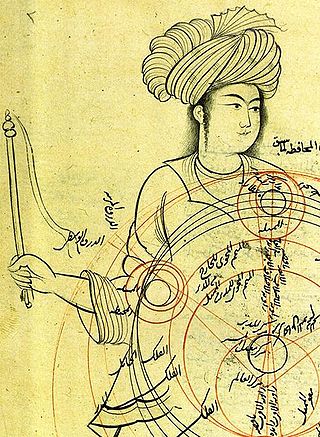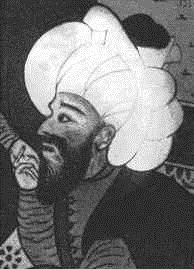Events
| | This section is empty. You can help by adding to it. (March 2017) |
This is a list of philosophy-related events in the 13th century .
| | This section is empty. You can help by adding to it. (March 2017) |
| | This section is empty. You can help by adding to it. (March 2017) |
Sharaf al-Dīn al-Muẓaffar ibn Muḥammad ibn al-Muẓaffar al-Ṭūsī known more often as Sharaf al-Dīn al-Ṭūsī or Sharaf ad-Dīn aṭ-Ṭūsī, was an Iranian mathematician and astronomer of the Islamic Golden Age.

Maragheh, also Romanized as Marāgha and Marāgheh, is a city in the Central District of Maragheh County, East Azerbaijan province, Iran, serving as capital of both the county and the district.

Qotb al-Din Mahmoud b. Zia al-Din Mas'ud b. Mosleh Shirazi was a 13th-century Persian polymath and poet who made contributions to astronomy, mathematics, medicine, physics, music theory, philosophy and Sufism.
Shams al-Dīn Muḥammad ibn Ashraf al-Ḥusaynī al-Samarqandī was a 13th century Persian astronomer and mathematician from Samarkand, now in Uzbekistan.

The Tusi couple is a mathematical device in which a small circle rotates inside a larger circle twice the diameter of the smaller circle. Rotations of the circles cause a point on the circumference of the smaller circle to oscillate back and forth in linear motion along a diameter of the larger circle. The Tusi couple is a 2-cusped hypocycloid.
Islamic cosmology is the cosmology of Islamic societies. It is mainly derived from the Qur'an, Hadith, Sunnah, and current Islamic as well as other pre-Islamic sources. The Qur'an itself mentions seven heavens.

The Maragheh observatory, also spelled Maragha, Maragah, Marageh, and Maraga, was an astronomical observatory established in the mid 13th century under the patronage of the Ilkhanid Hulagu and the directorship of Nasir al-Din al-Tusi, a Persian scientist and astronomer. The observatory is located on the west side of Maragheh, which is situated in today's East Azerbaijan Province of Iran. It was considered one of the most advanced scientific institutions in Eurasia because it was a center for many groundbreaking calculations in mathematics and astronomy. It housed a large collection of astronomical instruments and books and it served as an educational institution. It was also used as a model for the later Ulugh Beg Observatory in Samarkand, the Taqi al-Din observatory in Constantinople, and Jai Singh observatory in Jaipur.
Abner of Burgos was a Jewish philosopher, a convert to Christianity and a polemical writer against his former religion. Known after his conversion as Alfonso of Valladolid or "Master Alfonso."

Ala al-Dīn Ali ibn Muhammed, known as Ali Qushji was a Timurid theologian, jurist, astronomer, mathematician and physicist, who settled in the Ottoman Empire some time before 1472. As a disciple of Ulugh Beg, he is best known for the development of astronomical physics independent from natural philosophy, and for providing empirical evidence for the Earth's rotation in his treatise, Concerning the Supposed Dependence of Astronomy upon Philosophy. In addition to his contributions to Ulugh Beg's famous work Zij-i-Sultani and to the founding of Sahn-ı Seman Medrese, one of the first centers for the study of various traditional Islamic sciences in the Ottoman Empire, Ali Kuşçu was also the author of several scientific works and textbooks on astronomy.
This is a list of articles in medieval philosophy.
Najm al-Dīn 'Alī ibn 'Umar al-Qazwīnī al-Kātibī was a Persian Islamic philosopher and logician of the Shafi`i school. A student of Athīr al-Dīn al-Abharī. His most important works are a treatise on logic, Al-Risala al-Shamsiyya, and one on metaphysics and the natural sciences, Hikmat al-'Ain.
Many early Islamic philosophers and logicians discussed the liar paradox. Their work on the subject began in the 10th century and continued to Athīr al-Dīn al-Abharī and Nasir al-Din al-Tusi of the middle 13th century and beyond. Although the Liar paradox has been well known in Greek and Latin traditions, the works of Arabic scholars have only recently been translated into English.

Muhammad ibn Muhammad ibn al-Hasan al-Tusi, also known as Nasir al-Din al-Tusi or simply as (al-)Tusi, was a Persian polymath, architect, philosopher, physician, scientist, and theologian. Nasir al-Din al-Tusi was a well published author, writing on subjects of math, engineering, prose, and mysticism. Additionally, al-Tusi made several scientific advancements. In astronomy, al-Tusi created very accurate tables of planetary motion, an updated planetary model, and critiques of Ptolemaic astronomy. He also made strides in logic, mathematics but especially trigonometry, biology, and chemistry. Nasir al-Din al-Tusi left behind a great legacy as well. Tusi is widely regarded as one of the greatest scientists of medieval Islam, since he is often considered the creator of trigonometry as a mathematical discipline in its own right. The Muslim scholar Ibn Khaldun (1332–1406) considered Tusi to be the greatest of the later Persian scholars. There is also reason to believe that he may have influenced Copernican heliocentrism.

Shams al-Din Muhammad b. Ahmad al-Khafri al-Kashi, known as Khafri, was an Iranian religious scholar and astronomer at the beginning of the Safavid dynasty. Before the arrival of Sheikh Baha'i in Iran, he was appointed as the major Shia jurist in the Safavid court. He was born in the city of Ḵafr, south east of Firuzābād in the region of Fārs. His exact date of birth is unknown but historical accounts estimate the date of his birth to be around the 1480s. He wrote on philosophy, religion, and astronomy, with the latter including a commentary on al-Tusi and critiques of al-Shirazi. Al-Khafri wrote works on theology and astronomy, indicating that Islamic scholars in his time and place saw no contradictions between Islam and science.

Nizam al-Din Hasan al-Nisaburi, whose full name was Nizam al-Din Hasan ibn Mohammad ibn Hossein Qumi Nishapuri was a Persian Sunni Islamic Shafi'i, Ash'ari scholar, mathematician, astronomer, jurist, Qur'an exegete, and poet.

Nasirean Ethics is a 13th century Persian book in philosophical ethics that is written by Khaje Nasir al-Din al-Tusi. This book is divided to three part: ethics, domestic economy and politics.
Tajrīd al-iʿtiqād or Tajrid al-Kalam is a work by Nasir al-Din al-Tusi about Shia beliefs in Islamic theology. Tajrīd is the most famous scholastic text in Shiite theology and most effective work in history of apologetic written by Nasir al-Dīn Ṭūsī.
Sharh al-Isharat is a philosophical commentary on Avicenna's book Al-isharat wa al-tanbihat. This commentary has been written by Nasir al-Din al-Tusi in defense of the philosophy of Avicenna in response to the criticism made against him by Fakhr al-Din al-Razi in a book of the same title.
This is a list of philosophy-related events in the 14th century.